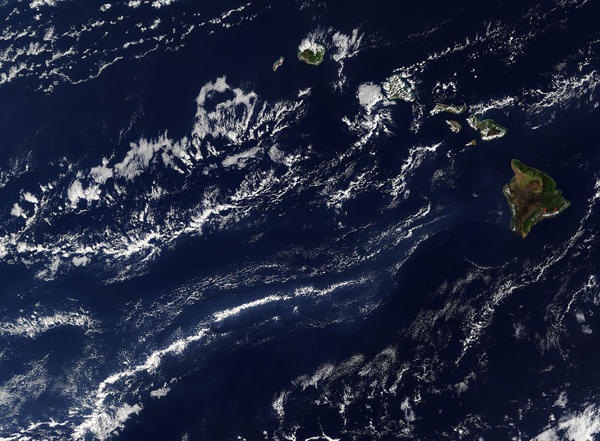Images
January 22, 2016 - Vog from Kilauea Volcano, Hawaii
Tweet
Kilauea, the youngest and most active volcano on Hawaii's Big Island, is currently continuing to vent lava and gas in one of the most long-lived volcanic eruptive phases on record for any volcano. The present eruption began in 1983 on the eastern side of the volcano, primarily at the Pu'u 'O'o vent.
On January 16, the Moderate Resolution Imaging Spectroradiometer (MODIS) aboard the Terra satellite flew over the Big Island and captured this true-color image. The image shows both the heat signature of the active volcanic vents and lava fields on the island, and also a broad band of vog spreading over the Pacific Ocean.
<>
Vog, also known as volcanic smog, occurs frequently at Kilauea and can have a deleterious effect on human and animal health, as well as agriculture in the region. According to the US Geologic Survey, sulfur dioxide gas and other pollutants which are emitted from Kilauea react with oxygen and atmospheric moisture to created vog and acid rain. People exposed to vog report stinging, discomfort, sinus problems and sometimes difficulty breathing. People with pre-existing conditions, such as asthma and seasonal allergies are advised to stay away from contact with the volcanic smog as it can make symptoms much worse.
Image Facts
Satellite:
Terra
Date Acquired: 1/16/2016
Resolutions:
1km (415.3 KB), 500m (1.4 MB), 250m (3.2 MB)
Bands Used: 1,4,3
Image Credit:
Jeff Schmaltz, MODIS Land Rapid Response Team, NASA GSFC
Tweet
Kilauea, the youngest and most active volcano on Hawaii's Big Island, is currently continuing to vent lava and gas in one of the most long-lived volcanic eruptive phases on record for any volcano. The present eruption began in 1983 on the eastern side of the volcano, primarily at the Pu'u 'O'o vent.
On January 16, the Moderate Resolution Imaging Spectroradiometer (MODIS) aboard the Terra satellite flew over the Big Island and captured this true-color image. The image shows both the heat signature of the active volcanic vents and lava fields on the island, and also a broad band of vog spreading over the Pacific Ocean.
<> Vog, also known as volcanic smog, occurs frequently at Kilauea and can have a deleterious effect on human and animal health, as well as agriculture in the region. According to the US Geologic Survey, sulfur dioxide gas and other pollutants which are emitted from Kilauea react with oxygen and atmospheric moisture to created vog and acid rain. People exposed to vog report stinging, discomfort, sinus problems and sometimes difficulty breathing. People with pre-existing conditions, such as asthma and seasonal allergies are advised to stay away from contact with the volcanic smog as it can make symptoms much worse.
Image Facts
Satellite:
Terra
Date Acquired: 1/16/2016
Resolutions:
1km (415.3 KB), 500m (1.4 MB), 250m (3.2 MB)
Bands Used: 1,4,3
Image Credit:
Jeff Schmaltz, MODIS Land Rapid Response Team, NASA GSFC




